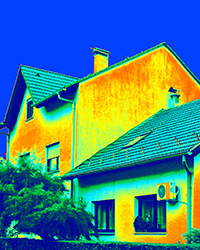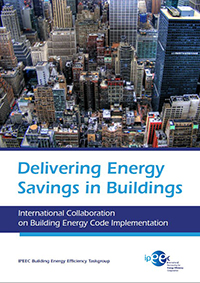Atmospher Sci & Global Chg
Research Highlights
December 2015
Laying a Foundation for International Energy Efficiency in Buildings
Energy efficiency cooperation through effective exchanges on building energy codes

Capturing energy savings. A thermal image of a home shows the intensity of radiant energy (measured as infrared) emitted from the surface of the home. The higher the energy intensity, the greater the energy lost from the interior of the building. Energy auditors and inspectors use infrared images to detect areas of a building not well insulated, and where there might be water or air leaks in a residence or commercial building. Building energy codes, as described in this report, are another tool used to capture energy saving.

The report is available from the International Partnership on Energy Efficiency Cooperation website.
Results: Across the globe, from skyscrapers to homes, shopping malls to warehouses, structures of all sorts consume about one-third of all energy produced. There is a great opportunity to reduce energy production by reducing energy use in existing and future buildings. To support a foundation for collaboration, researchers at Pacific Northwest National Laboratory, working with the Global Building Performance Network and other international partners, sought to understand various approaches to building energy codes and implementation measures. They published a report, which was delivered to the Major Economies Forum, the International Partnership for Energy Efficiency Cooperation, and the G-20 group, describing topics and approaches to international collaboration.
Summaries of code implementation practices in major economies are available through a web portal, which also includes a list of experts available to share recourses with practitioners and policymakers in various countries.
"All of the largest countries in the world have endorsed this report through the Major Economies Forum," said Meredydd Evans, energy codes expert at PNNL. "This endorsement highlights the importance of this arena of energy efficiency to world economies." Evans works at the Joint Global Change Research Institute, a collaboration between PNNL and the University of Maryland.
Why It Matters: Similar to structural and fire codes for buildings, energy codes are systems to establish, adopt, implement, and enforce building codes with an added focus: they promote and improve energy efficiency in buildings. The energy savings potential in the buildings sector is massive. Buildings account for over one-third of all energy consumption today and this figure is growing. Effective code implementation is the key to realizing substantial energy savings and accessing other benefits, such as lower energy bills, energy security, health, and comfort. International collaboration on learning of and exchanging best practices in code implementation can help ensure that building energy codes deliver full benefits.
Methods: Although there are differences in how they manage energy consumption, governments of all sizes are interested in collaborating on systems of building energy code compliance, performance measurement, and code implementation incentives.
With that in mind, PNNL researchers and team focused on 22 countries that account for about 70 percent of global building consumption, based on their membership in the Major Economies Forum, the International Partnership for Energy Efficiency Cooperation (in partnership with the Global Building Performance Network, GBPN) and the G-20 group (plus guests). They surveyed each of these countries by developing clear information on each country's building energy code policies from the literature.
Drawing on the existing situation with building energy codes around the world, the team proposed potential areas and forms of collaboration, and reached out for feedback from the experts through structured interviews. Sharing preliminary findings with global experts came through web meetings.
The final report went through several rounds of global peer review by experts from the participating countries. The compiled information on building energy codes in the participating countries was released through a structured web portal, which covers important implementation topics.
What's Next? The report lays out several next steps for global collaboration on building energy code implementation, covering code compliance checking systems, measuring performance against code-required design, code compliance software, and incentives. The types of collaboration may include developing a best practice guide, conducting collaborative studies, updating and expanding the web portal, and conducting global webinars.
Acknowledgments
Sponsor: The Department of Energy's Office of International Activities provided financial support for the research.
Research Team: Meredydd Evans, Elizabeth Malone, Volha Roshchanka, Bo Liu, and Sha Yu, PNNL; Peter Graham, Naimh McDonald, and Claire Brule, the Global Buildings Performance Network.
Research Area: Climate & Earth Systems Science
Reference: International Partnership on Energy Efficiency Cooperation (IPEEC). 2015. "Delivering Energy Savings in Buildings: International Collaboration on Building Energy Code Implementation." Available at: http://ipeec.org/publications.
